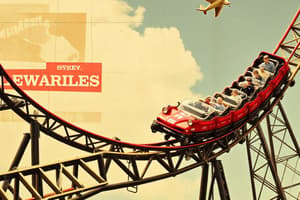Podcast
Questions and Answers
What occurs to the potential energy as the train descends the ramp?
What occurs to the potential energy as the train descends the ramp?
- It becomes gravitational energy.
- It remains constant regardless of the mass.
- It is converted into kinetic energy. (correct)
- It decreases rapidly with more mass.
What is one key observation regarding the effect of mass on the height reached by the train?
What is one key observation regarding the effect of mass on the height reached by the train?
- Lighter trains do not reach any height.
- Heavier trains reach a higher height.
- All trains reach the same height regardless of mass. (correct)
- The height reached is proportional to the mass.
What should be done before measuring the height reached by the train with coins?
What should be done before measuring the height reached by the train with coins?
- Adjust the ramp angle.
- Fill the train with additional weight.
- Remove all coins from the cars. (correct)
- Measure the initial height.
What happens to the kinetic energy of the train when it rises up the ramp on the other side?
What happens to the kinetic energy of the train when it rises up the ramp on the other side?
Which experiment does the content reference to compare results regarding mass and energy?
Which experiment does the content reference to compare results regarding mass and energy?
What is the relationship between net force and acceleration?
What is the relationship between net force and acceleration?
How does mass affect acceleration according to the given principles?
How does mass affect acceleration according to the given principles?
What force acts as a reaction to the force exerted by the thrusters of a rocket?
What force acts as a reaction to the force exerted by the thrusters of a rocket?
When comparing two objects with different masses, what can be concluded about their accelerations if a constant net force is applied?
When comparing two objects with different masses, what can be concluded about their accelerations if a constant net force is applied?
What happens when the net force on an object is doubled while keeping the mass constant?
What happens when the net force on an object is doubled while keeping the mass constant?
What will be the effect on acceleration if the thrust of a rocket is increased significantly while overcoming the mass of the fuel?
What will be the effect on acceleration if the thrust of a rocket is increased significantly while overcoming the mass of the fuel?
What does the normal force represent in the context of forces acting on an object?
What does the normal force represent in the context of forces acting on an object?
What is the implication of acceleration being directly proportional to net force but inversely proportional to mass?
What is the implication of acceleration being directly proportional to net force but inversely proportional to mass?
What happens to the energy when the train travels up the ramp?
What happens to the energy when the train travels up the ramp?
Why does the train not make it to the top of the ramp despite theoretically having enough energy?
Why does the train not make it to the top of the ramp despite theoretically having enough energy?
In the equation PEstart + KEstart = PEfinish + KEfinish + Edissipated, what does Edissipated represent?
In the equation PEstart + KEstart = PEfinish + KEfinish + Edissipated, what does Edissipated represent?
What is the goal of pushing the train with extra energy?
What is the goal of pushing the train with extra energy?
What is required for the train to successfully navigate around a vertical loop?
What is required for the train to successfully navigate around a vertical loop?
If the train stops right at the top of the other hill, what does that indicate about the energy supplied?
If the train stops right at the top of the other hill, what does that indicate about the energy supplied?
Which statement best describes the relationship between potential energy and kinetic energy during the train's journey?
Which statement best describes the relationship between potential energy and kinetic energy during the train's journey?
What is a key factor that affects whether the train can make it around the loop?
What is a key factor that affects whether the train can make it around the loop?
What is the first step in Experiment 13?
What is the first step in Experiment 13?
Which equipment is needed for Experiment 14?
Which equipment is needed for Experiment 14?
When testing the train over different hill configurations, what should you observe?
When testing the train over different hill configurations, what should you observe?
What is the purpose of measuring the track length in Experiment 14?
What is the purpose of measuring the track length in Experiment 14?
How many track pieces are used when assembling the oval model for Experiment 14?
How many track pieces are used when assembling the oval model for Experiment 14?
What action should be taken to start timing in Experiment 14?
What action should be taken to start timing in Experiment 14?
What feature is critical to determine if a train can pass over a hill?
What feature is critical to determine if a train can pass over a hill?
Why might the train not clear the hill during tests?
Why might the train not clear the hill during tests?
What does Newton's first law state about an object in motion?
What does Newton's first law state about an object in motion?
When a roller coaster accelerates forward, what sensation do riders experience due to Newton's first law?
When a roller coaster accelerates forward, what sensation do riders experience due to Newton's first law?
What does Newton's second law relate to the motion of an object?
What does Newton's second law relate to the motion of an object?
What is the significance of inertia as described by Newton's first law?
What is the significance of inertia as described by Newton's first law?
What occurs according to Newton's third law?
What occurs according to Newton's third law?
How does the force exerted by the seat on the rider during a roller coaster ride explain Newton's second law?
How does the force exerted by the seat on the rider during a roller coaster ride explain Newton's second law?
What happens when a small amount of force is applied to the train at the launcher?
What happens when a small amount of force is applied to the train at the launcher?
In the context of roller coasters, how does mass affect the acceleration of the coaster according to Newton's second law?
In the context of roller coasters, how does mass affect the acceleration of the coaster according to Newton's second law?
Flashcards are hidden until you start studying
Study Notes
Newton's Laws
- Newton's First Law: An object in motion stays in motion (or at rest), unless acted upon by an unbalanced force. Objects resist changes in motion due to inertia.
- Newton's Second Law: The force on an object is equal to its mass times its acceleration (Fnet = ma). Acceleration is directly proportional to force and inversely proportional to mass.
- Newton's Third Law: All forces come in pairs. For every action, there is an equal and opposite reaction.
Roller Coaster Engineering
- The higher a roller coaster starts, the faster it goes at the bottom of the hill and vice-versa.
- Potential energy is stored energy due to an object's position.
- Kinetic energy is the energy of motion.
- A heavier roller coaster has more potential energy at a given height.
- Energy can be transferred from potential to kinetic energy and back again.
- Energy is lost due to friction as a roller coaster moves.
Loops and Hills
- A roller coaster needs enough energy to complete a loop.
- The higher the loop, the more energy needed.
- The tallest hill a roller coaster can climb depends on its initial energy.
- A roller coaster's speed can be measured using a stopwatch and the distance traveled.
Studying That Suits You
Use AI to generate personalized quizzes and flashcards to suit your learning preferences.




